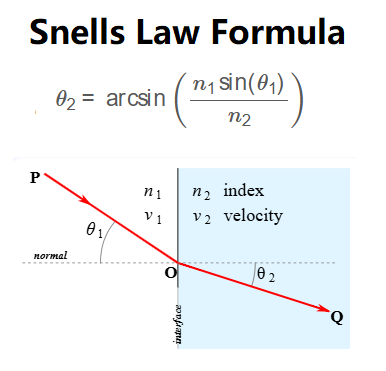1. What is Snell's Law Calculator?
Definition: This calculator computes the angle of refraction (\( \theta_2 \)) of a light ray passing from one medium to another using Snell's Law, which relates the angles of incidence and refraction to the refractive indices of the two media.
Purpose: It is used in optics to predict how light bends when transitioning between media, such as from air to water, which is essential in designing lenses, prisms, and optical instruments.
2. How Does the Calculator Work?
The calculator uses Snell's Law:
Formula:
\[
n_1 \sin(\theta_1) = n_2 \sin(\theta_2)
\]
Rearranged to solve for \( \theta_2 \):
\[
\theta_2 = \arcsin\left(\frac{n_1 \sin(\theta_1)}{n_2}\right)
\]
Where:
- \( n_1 \): Refractive index of medium 1 (dimensionless)
- \( n_2 \): Refractive index of medium 2 (dimensionless)
- \( \theta_1 \): Angle of incidence (degrees)
- \( \theta_2 \): Angle of refraction (degrees)
Steps:
- Select the two media or input custom refractive indices (\( n_1 \), \( n_2 \)).
- Enter the angle of incidence (\( \theta_1 \)) in degrees.
- Validate \( \theta_1 \) (must be between 0 and 90 degrees).
- Convert \( \theta_1 \) to radians for calculation.
- Calculate \( \sin(\theta_2) \) using Snell's Law: \( \sin(\theta_2) = \frac{n_1 \sin(\theta_1)}{n_2} \).
- Check for total internal reflection (if \( |\sin(\theta_2)| > 1 \), refraction is not possible).
- Calculate \( \theta_2 = \arcsin(\sin(\theta_2)) \).
- Convert \( \theta_2 \) to degrees for display.
- Display the result, using scientific notation for values less than 0.001, otherwise with 4 decimal places.
3. Importance of Snell's Law Calculation
Calculating the angle of refraction using Snell's Law is crucial for:
- Optical Design: Designing lenses, prisms, and fiber optics by predicting light paths.
- Physics Education: Understanding the principles of light refraction in different media.
- Photography: Adjusting for light bending in underwater photography or through glass.
4. Using the Calculator
Examples:
- Example 1: For \( n_1 = 1.0 \) (Vacuum), \( n_2 = 1.333 \) (Water at 20°C), \( \theta_1 = 30 \, \text{degrees} \):
- Convert: \( \theta_1 = 30 \times \pi/180 = \pi/6 \, \text{radians} \)
- Calculate: \( \sin(\theta_2) = \frac{1.0 \cdot \sin(\pi/6)}{1.333} \approx 0.375 \)
- Angle of Refraction: \( \theta_2 = \arcsin(0.375) \approx 0.384 \, \text{radians} \), in degrees: \( 0.384 \times 180/\pi \approx 22.02 \, \text{degrees} \)
- Example 2: For \( n_1 = 1.52 \) (Window glass), \( n_2 = 2.419 \) (Diamond), \( \theta_1 = 57.30 \, \text{degrees} \):
- Convert: \( \theta_1 = 57.30 \times \pi/180 \approx 1.0 \, \text{radians} \)
- Calculate: \( \sin(\theta_2) = \frac{1.52 \cdot \sin(1.0)}{2.419} \approx 0.527 \)
- Angle of Refraction: \( \theta_2 = \arcsin(0.527) \approx 0.553 \, \text{radians} \), in degrees: \( 0.553 \times 180/\pi \approx 31.67 \, \text{degrees} \)
5. Frequently Asked Questions (FAQ)
Q: What is Snell's Law?
A: Snell's Law describes how light bends when it passes from one medium to another, relating the angles of incidence and refraction to the refractive indices of the media.
Q: What is total internal reflection?
A: Total internal reflection occurs when the angle of incidence exceeds the critical angle, causing the light to reflect entirely within the first medium instead of refracting into the second.
Q: Why must the refractive indices be positive?
A: Refractive indices represent the optical density of a medium and are always positive in physical contexts, as they are defined relative to the speed of light in a vacuum.
 Home
Home
 Back
Back
